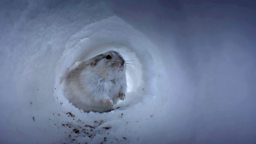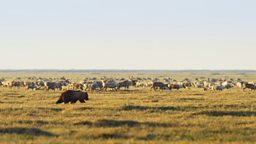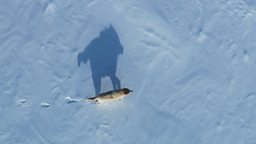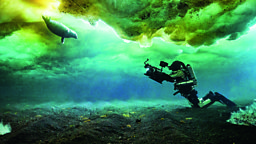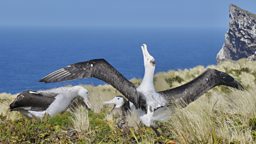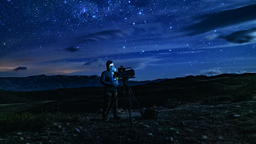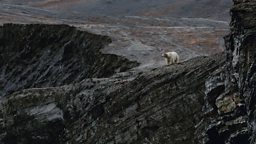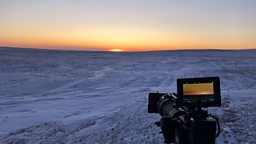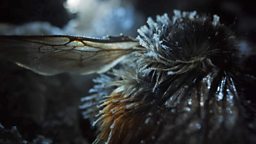Getting eye level with the wolves hunting bison
By Will Lawson, Assistant Producer for Frozen Planet

easier said than done!
Canada’s Wood Buffalo National Park is vast! At over two times the size of Wales covering the ground to find our animals (never mind film them), was always going to be a logistical challenge. On top of this, the wolves are incredibly mobile - often travelling ten miles or more in a day and twice that when pursuing buffalo! Knowing this ahead of the shoot meant using a helicopter was essential. But to make the sequence really special, we needed to not just film from above but also from down at wolf and buffalo eye level! It wasn’t until we got on the ground that it dawned on me; that would be easier said than done!

With our intent to spend as much time on the ground with the animals as possible, we had a plan in place; using the helicopter drop-off part of the team nearby (1-2km) and (quietly) walk-in. Pretty simple!
it was a baptism of snow
I remember the first time Justin Maguire (camera operator) and I were dropped in position; it was to approach the wolf pack. First of all, it was a baptism of snow: to drop us the helicopter only semi-lands – not wanting the skids to sink too far into the snow - so it’s a race to get out as the props whir overhead, unload the kit and strap down or lie on as much of it as possible so nothing gets swept into the rotors! Then the aerial team quickly take-off and the helicopter's blizzard-like downdraught blasts you to smithereens with the crystalline snow! Only as its rhythmic beats died into the distance, did we feel like it was safe to put our heads up! It’s all a bit unceremonious!

But after that adrenaline rush, you’re left in the vast, quiet and seemingly peaceful landscape. I recall being quickly snapped back to the reality of the situation while strapping into snowshoes, loading up the sleds with the gear and starting the painstaking process of breaking trail.
you’re left in the vast, quiet and seemingly peaceful landscape
The next challenge was moving all the kit around. The unpredictable weather and being 30-50 miles from base meant each time the helicopter dropped the ground team they needed to be self-sufficient for a few days (tent, sleeping bags, rations, first aid, spare clothes, etc): a pick-up was no guarantee! The resultant survival gear and filming kit was a sizable 60kg snow anchor to each person dragging it through that vast landscape!
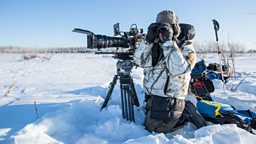
If you’ve never broken a trail before in deep snow while pulling a sled, there are many expressions that come to mind, but the nicest is “it’s hard!" In our case, the top 5cm of the snow was the crust and the dream was to not break the crust and glide over the smooth surface. In reality nearly every step we broke through and sunk in up to our knees. It’s exhausting. In my head it quickly became a disappointing mind-game of “this step might actually not break the crust!”, only to then, break the crust… The sleds added another level of frustration as it didn’t take long before the bulky gear shifted enough for the sled to tip over and anchor you to the spot.
there are many expressions that come to mind, but the nicest is “it’s hard!”
So, whilst we (as quietly as possible) wrestled with snow and sleds, we slowly edged closer and closer to the wolves' position. In order to stand any chance of success, way overhead our spotter plane kept a birds-eye-view and radioed down to give us updates – a quiet squawk on the radio to say “no change in the wolves, you’re on track” was much-needed encouragement.

we were left hot and very bothered in their trail
Having taken an hour to snowshoe 1,500 metres, Justin and I were on track and picking a final approach when the radio quietly squawked “guys the wolves are getting up and stretching”! ‘Insert expletive’! We quickly changed our approach to try and get ahead of where they might start moving. After a few more minutes of accelerated grunting and sled wrestling, we were only about 100 metres away! Another squawk; “Guys, you better be quick. The whole pack is up and moving, you’re going the right way but they’re not hanging around.” Noooo! Ten minutes later the pack had moved the best part of three kilometres, and we were left hot and very bothered in their trail! It had taken us an hour and a lot of sweat to do just a third of the distance – our approach needed a re-think!
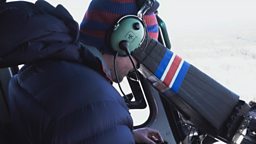
we got a window of opportunity we thought might just work!
Over the next few days, we tried a range of approaches; from pre-empting the direction the wolves were moving and dropping the team ahead, to waiting until they were preoccupied with buffalo and sneaking up on them. All had varying levels of disappointment. But as is often the case on these shoots, it was on the last day when somehow, we got a window of opportunity we thought might just work!

we dropped the ground team as close to the action as was safe
I was in the spotter plane, and we had relocated the wolf pack in the process of harassing buffalos. With our update received, the helicopter scrambled from base with ground and aerial team aboard and raced to the scene. Making a snap decision we dropped the ground team as close to the action as was safe, then took off again to attempt to film the hunt from the air – something we had not yet seen! The ground team could only prepare the kit, sit and wait.
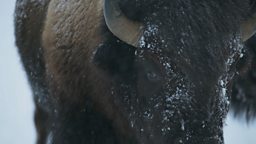
singling out a target had begun
I remember watching from the spotter plane taking in the scene as it unfolded far below me – it was everything we’d waited nearly a month to witness! The wolves had got the bison on the run and the process of singling out a target had begun.
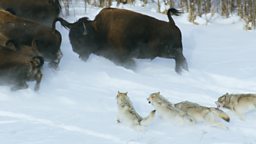
All the while both species galloped through the deep snow relentlessly
While I watched, mesmerised, the wolves tag-team with their pack members and buffalo cut through dense willows like they were grass. All the while both species galloped through the deep snow relentlessly: how many miles they covered in that chase I don’t know but the speed and unwavering endurance of both species was quite frankly terrifying! It made me realise that for both predator and prey adapting and surviving in this frozen world wasn’t just about thick fur and finding food; it was also about power, endurance, strategy and more.
